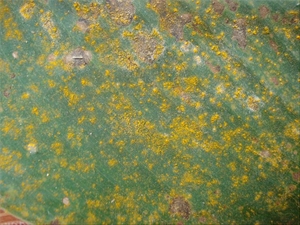Canna rust
Pacific Pests, Pathogens, Weeds & Pesticides - Online edition
Pacific Pests, Pathogens, Weeds & Pesticides
Canna rust (193)
Puccinia thaliae (previously known as Puccinia cannae).
Southeast Asia, Africa, North, South and Central America, Oceania. It is recorded from American Samoa, Fiji, and Solomon Islands.
Canna and relatives.
Symptoms include yellow to tan spots (pustules) on leaves and stems (Photo 1). The pustules often develop in lines parallel to the leaf veins (Photo 2). They release masses of spores ('urediniospores') (Photo 3). Later, another type of spore develops ('teliospores'), mainly on the lower surface but also on the upper surface. The spots turn brown-to-black as they develop (Photo 4). The infected leaves eventually become dry and fall prematurely.
As the pustules burst open the spores are spread by wind over short and long distances. The spores germinate in water on the surface of susceptible host plants and infect through natural openings ('stomata'). Warm, humid weather, such as occurs in Pacific island countries favours the development of the disease.
Rust fungi have complex life cycles and produce many types of spores. Some rusts, like the darker teliospores mentioned above, have resistant cell walls which allow the rust to survive when hosts are not available. Later, they germinate and produce other spore types to continue the life cycle.
The disease is called 'rust' because of the powdery spores. If you wipe a finger over the leaf, it appears similar to touching rusty iron - a fine dark brown stain remains.
In severe cases of attack, the leaves yellow and wither prematurely, and plants lose their ornamental quality.
Look for the orange powdery pustules on the lower leaf surface, turning darker above. Look for the early death of the leaves, as they dry up because of the rust infection.
CULTURAL CONTROL
When Canna rust first appears, remove the infected leaves and burn them, otherwise the fungus will spread rapidly and infect all the leaves. The affected foliage should not be composted, as that will simply spread the fungus further.
CHEMICAL CONTROL
If fungicides are needed to maintain the appearance of this ornamental plant, use copper products or mancozeb.
____________________
When using a pesticide, always wear protective clothing and follow the instructions on the product label, such as dosage, timing of application, and pre-harvest interval. Recommendations will vary with the crop and system of cultivation. Expert advice on the most appropriate pesticides to use should always be sought from local agricultural authorities.
AUTHOR Grahame Jackson
Information from (including Photos 1,3&4) McKenzie, E. (2014) Puccinia thaliae: PaDIL - (http://www.padil.gov.au); and from Bhasabutra T, et al. (2011) Canna rust (Puccinia thaliae): PaDIL - http://www.padil.gov.au; Nelson S (2013) Rust of Canna Lily. College of Tropical Agriculture and Human Resources, University of Hawai'i at Manoa. (https://www.ctahr.hawaii.edu/oc/freepubs/pdf/PD-96.pdf). Photo 2 Kohler F, et al. (1997) Diseases of cultivated crops in Pacific Island countries. South Pacific Commission. Pirie Printers Pty Limited, Canberra, Australia.
Produced with support from the Australian Centre for International Agricultural Research under project PC/2010/090: Strengthening integrated crop management research in the Pacific Islands in support of sustainable intensification of high-value crop production, implemented by the University of Queensland and the Secretariat of the Pacific Community.







